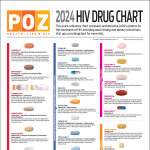Antiretroviral (ARV) therapy accounts for the lion’s share of health care costs for people living with HIV in the United States, according to an article published online September 20 in the journal AIDS.
HIV care is expensive, and it has been since the beginning of the HIV epidemic. In 1996, average costs exceeded $20,000 per year in the United States. By 1998, this had dropped slightly to $18,300 per year.
Though most people with HIV do not pay for the entire cost of their health care out of their own personal incomes or savings, the high price of HIV disease management does have direct financial implications for many positive people.
Cash-strapped states around the country have been cutting costs in a number of ways. Several states, for example, have made it harder to qualify for waiting lists for AIDS Drug Assistance Programs (ADAPs). And for people with private health insurance, drug co-payments and deductibles have risen sharply in recent years.
To work toward effective cost-containment measures, policy makers and advocates first need to understand the overall cost of HIV care in the United States, and where those costs are coming from. There have been no comprehensive costs assessments conducted since at least 2000, when contemporary ARV regimens in were first introduced.
To help answer this question, Kelly Gebo, MD, MPH, from Johns Hopkins University School of Medicine in Baltimore, and her colleagues examined data from 14,691 adults who received HIV care in 2006 at a consortium of high-volume HIV clinics across the country.
The majority of the study participants were older than 40, the majority were black or Latino, and 71 percent were male. About 6 percent had CD4s under 50, 15 percent had CD4s between 51 and 200, 45 percent had CD4s between 201 and 500, and 35 percent had CD4s over 500. ARV use was about 80 to 85 percent in most CD4 ranges.
Gebo’s group found that the average annual cost of HIV care in the study was $19,912, with most people racking up costs between $11,045 to $22,626 per year. Total costs were substantially lower for people with less advanced HIV disease. For people with CD4s under 50, the average yearly cost was $40,678. For people with CD4s over 500, the average cost was $16,614.
ARVs represented a significant proportion of the costs of HIV-related care. For people with the highest CD4 counts, ARVs accounted for as much as 74 percent of all health care costs. Even in people with very low CD4s, where hospitalization and other costly procedures are most common, ARVs still represented 23 percent of all costs.
For people with less advanced HIV disease, the primary costs aside from antiretrovirals were non-HIV medications, outpatient provider visits and drug resistance testing. For those with advanced disease, the highest cost by far was for inpatient treatment, followed by opportunistic infection treatment and prevention.
“The annual per-person costs of care for HIV-infected patients in the United States are high,” the authors write. “It is misleading to focus on a single number as representing ‘the’ cost of treating HIV infection. Costs estimates varied greatly, depending on severity of illness.”
They conclude: “Given the potential increases in costs of therapeutic agents, toxicities and comorbidities due to [ARVs], and aging-related comorbidities, it is likely that the aggregate costs of HIV care will continue to increase for the foreseeable future.”
Advertisement
Advertisement
Advertisement






1 Comment
1 Comment